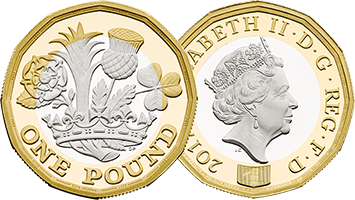Using image analysis and signal processing technology to fight high-tech counterfeiters
Sir Isaac Newton would be proud of the new £1 coin. After joining The Royal Mint in 1696, Newton took on counterfeiters with a combination of science and art. He introduced features, such as grooved edges on coins, to make it next to impossible to counterfeit Britain’s currency. He believed that the best way to deter counterfeiting was to create the highest quality coin.
With each advancement in minting, counterfeiters became more sophisticated. For the last three centuries, the battle against counterfeit currency continued. According to The Royal Mint, approximately 1 in 30 round £1 coins were counterfeit, meaning nearly £45 million of counterfeit £1 coins were in circulation., The Royal Mint designed a new £1 coin with both overt and covert security features designed to foil counterfeiters. This new coin is said to be the world’s most secure coin.
The Royal Mint and the new £1 coin
The overt security features of the new coin are designed to make the coin extremely difficult to copy. They include a 12-sided shape, micro-lettering on the lower inside rim on both sides of the coin, a bimetallic finish, alternate milled edges, and a latent image that works like a hologram.
But it’s the combination of overt features and a covert security feature that makes this coin the most secure coin in the world. It is this covert feature that also enables coin handling machines, such as those used in banks, to determine authenticity.
The technology that The Royal Mint has adopted in its High-Security Feature has been used in other sectors, such as the banknote industry, for a number of years. It has now been successfully transferred to metals and coinage for the first time by The Royal Mint’s team of expert scientists.
The Telegraph reported, “According to patent experts at Ashfords International Patenting Services The Royal Mint’s technology ensures that the special particles don’t merely form a coating, but are actually part of the alloy of the material forming the new coin.”
Electromagnetic signature
When researchers presented their work on the 12-sided £1 coin at the recent MathWorks event, they described how the battle against counterfeiting in the coin industry has driven innovation. The move to adopt electromagnetic signatures has enabled machines to authenticate coins, much like they do for passports and banknotes.
When a new £1 coin is produced, a patented chemical inclusion is deposited during the nickel-plating phase. Since it is dispersed throughout the nickel layer, it will last the entire time the coin is in circulation, resistant to both chemicals and wear.
This is a finely controlled process: too little and the coins fail to register in the detector, too much is a waste of costly materials.
Image Analysis
During their development, The Royal Mint tested the distribution of the inclusion by preparing metallurgical micrographs and then analyzing the degree of clustering with a MATLAB algorithm. By automating this process, the analysis time was reduced by 50%. MATLAB image processing capability then enabled them to detect the level of dispersion throughout the nickel plating and adjust the process to obtain a more uniform dispersion.
Over 100 million coins were manufactured initially. Before the coins were ready for distribution, a detection algorithm was developed to enable the technology to verify coins at a rate of 1000 per minute.
Detection algorithm
The detection algorithm used in coin sorter machines tests for physical properties, such as thickness, as well as the signal data from the chemical inclusion. To test the chemical inclusion, oscilloscope readings were performed as the coin moved through the detection unit, and the signal processing data were then analyzed with MATLAB.
The team used the analysis to develop a robust detection algorithm which successfully detected 100% of the legitimate coins during testing. The confidence in the counterfeit detection algorithm helped ensure that they were ready for launch.
No counterfeits found!
1.4 billion new £1 coins have been created and no counterfeits have been reported. Sir Isaac Newton would indeed be proud.
 Cleve’s Corner: Cleve Moler on Mathematics and Computing
Cleve’s Corner: Cleve Moler on Mathematics and Computing The MATLAB Blog
The MATLAB Blog Guy on Simulink
Guy on Simulink MATLAB Community
MATLAB Community Artificial Intelligence
Artificial Intelligence Developer Zone
Developer Zone Stuart’s MATLAB Videos
Stuart’s MATLAB Videos Behind the Headlines
Behind the Headlines File Exchange Pick of the Week
File Exchange Pick of the Week Hans on IoT
Hans on IoT Student Lounge
Student Lounge MATLAB ユーザーコミュニティー
MATLAB ユーザーコミュニティー Startups, Accelerators, & Entrepreneurs
Startups, Accelerators, & Entrepreneurs Autonomous Systems
Autonomous Systems Quantitative Finance
Quantitative Finance MATLAB Graphics and App Building
MATLAB Graphics and App Building









评论
要发表评论,请点击 此处 登录到您的 MathWorks 帐户或创建一个新帐户。